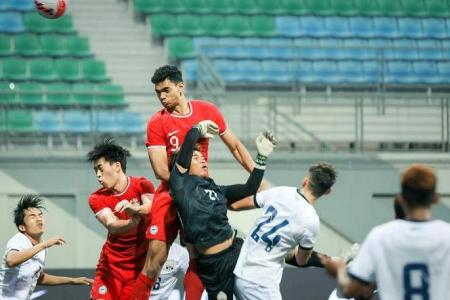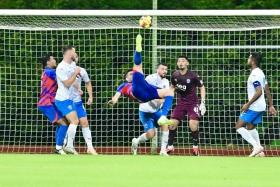Young Lions will be one of the weakest teams at SEA Games: Ex-Lion Sasikumar
SINGAPORE – Zero golds, three silvers and seven bronzes. Singapore’s record at the SEA Games men’s football competition has made for dismal reading since its inception in 1959.
The Republic have never won the biennial tournament, which has been an age-group event since the 2001 edition. All three silvers came in the 1980s (1983, 1985, 1989). They last qualified for the semi-finals in 2013 and beat Malaysia for bronze.
The drought looks set to continue at the May 5-17 Games in Phnom Penh after an abject showing at the Merlion Cup saw the Singapore Under-22s beaten by their counterparts from Hong Kong and Cambodia.
After the March 24 defeat by Hong Kong, Young Lions coach Philippe Aw attributed the poor performance to mistakes that were made 10 years ago and urged fans to wait another decade for results to show.
But former Lions defender R. Sasikumar, 48, is unconvinced. He told The Straits Times: “What surprises me is the people who have been there doing the same job over the last 10 years are still involved today. They had some part to play when these boys were 14 or 15. Saying that this is a work of 10 years and doing the same thing over and over again is insanity.”
About Singapore’s SEA Games prospects, Sasikumar, who refused to blame the players, added: “Losing to Cambodia is probably the final nail in the coffin. Let’s not set ourselves up for disappointment (at the SEA Games) and manage expectations.
“In such a short space of time, the only thing left to do is to focus on our set pieces. Sometimes in tournaments, you can get by with luck. But we are probably one of the weakest teams going into this tournament.”
With criticism coming over social media from local fans and pundits, Sasikumar and other observers have identified areas where the team can improve.
These include having more local Singapore Premier League (SPL) clubs and youth facilities to create a larger talent pool, establishing clearly defined age-group teams in the national set-up and transparent top-down communication from key decision-makers.
On increasing the pool of players, Sasikumar said: “The talent pipeline has dried up. In 1998, we had almost 30 teams across three divisions.
“Now we have only six local clubs (in the top tier) discounting Young Lions, (Brunei) DPMM and Albirex (Niigata). The Singapore Football League clubs in Division Two are dwindling in quality and numbers. While the School Football Academies (SFAs) are producing players, there are not enough clubs for them to go to in the SPL.”
In the late 1990s and early 2000s, the S-League, the SPL’s predecessor, saw 12 local teams taking part. But financial issues resulted in the withdrawal of several clubs.
While the tip of the football pyramid appears to have narrowed over the years, the base seems affected as well. Sasikumar added: “I got a text message from a parent, whose son has been playing at a local academy at Turf City for years, saying the facility is going to be taken away soon. Almost 3,000 kids won’t know where else to play.”
Tenants at Turf City were given a final extension of their lease until the end of 2023. Till today, the fate of its sports academies and facilities remains unclear.
With a limited talent pool in Singapore, ensuring continuity in age-group teams to allow players to develop through the ranks becomes essential.
Khidhir Khamis, former Balestier Khalsa coach, said: “There is too much chopping and changing. When I was coaching, there were only leagues for Under-16, Under-18 and Prime League. And after that they wanted to have a small tournament for Under-14 teams.
“That was eventually scrapped and the leagues were changed to Under-15 and Under-17. There was nothing for players under the age of 15 at that time. We need to have proper platforms for these kids to compete which we didn’t have for the past decade.”
As part of the Unleash the Roar! (UTR) project, the SFA programme was launched in 2022. It currently has 12 schools – 10 boys’ and two girls’ squads – on board and is planning to expand its reach to 16 schools by the end of 2023.
Under this programme, talented players aged 13 to 16 will train four times a week, play more competitions and go for overseas training stints. They will also follow a structured training programme incorporating sports science.
While acknowledging the UTR project is far from perfect, both Sasikumar and Khidhir agree some positive steps have been taken.
Sasikumar, a member of the UTR executive committee, said: “It’s better to have some movement than nothing at all. Everybody is pulling together and we have got support from the top. We have people who understand the local context spending hours on the field looking for talent.”
For former Lions goalkeeper Yakob Hashim, however, the key to progress is transparency.
The 62-year-old said: “We need to get the three most important stakeholders – UTR, SPL clubs and the Football Association of Singapore – to have an open and honest discussion with coaches and players who have played at the highest level.
“They need to set clear directions and communicate clearly, not just having internal meetings. What happened to the talent pipeline? Why have we declined? Ultimately, these questions need to be answered.”
Get The New Paper on your phone with the free TNP app. Download from the Apple App Store or Google Play Store now



